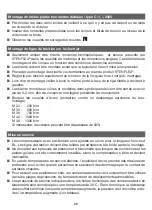
19
Installation instructions for angular expansion joints
for equalising angular movements
Q
Angular expansion joints require light fixed points on both sides. These must absorb the
adjusting forces of the expansion joints as well as the friction on joints and pipe guides.
Q
Fix-position the piping fixed points after installation of the expansion joint (after tighte-
ning the flange screws). Failure to observe these instructions can lead to a destruction
of the expansion joint.
Q
In principle, only one equalising system shall be positioned between two fixed points.
Q
Suitable piping guides shall be installed on equalising systems for absorbing the weight
forces.
Q
Angular expansion joints have a certain defined turning axis around which they can be
swivelled. Ensure for correct position of the turning axis when performing installation.
Q
Angular expansion joints can be pre-tensioned. As a rule, pre-tensioning is performed by
half of the movement listed in the dimension sheets.
Installation of a pre-tensioned equalising system
with 2 angular expansion joints
Fig.
Connect piping (2) with the fixed points. Install expansion joints (1) in neutral posi-
tion. The piping leading further is lying on the guide bearing.
Fig.
Take out the removal piece (3). With the use of a suitable device, shift the expan-
sion joints (1) from the neutral position to such an extent until the construction gap
(4) is closed. Screw-connect or weld the construction gap (4) as required.
Fig.
The movement intake depends on the expansion joint middle spacing and the
max. allowable deflection angle. Calculation is performed according to the fol-
lowing equation:
The expanding piping must have adequate freedom of movement in the guide
bearing.
L = Expansion joint middle spacing (mm)
= Movement intake (mm)
h = Movement freedom in the guide bearing (mm)
= Angle of deflection
Installation of a pre-tensioned equalising system
with 3 angular expansion joints
Fig.
Connect piping (2) with the fixed points. Install expansion joints (1) in neutral posi-
tion. The piping leading further is lying on the guide bearing.
ꔴ
C
h = L [ 1 – cos
]
L = ——— — = L sin
/2
sin
2
ꔴ
D
Summary of Contents for A Series
Page 2: ...2 ꔴ A ꔴ A 9 9 9 9 10 11 12 ...
Page 3: ...3 ꔴ B ꔴ M 3 3 3 3 2 3 3 FFP F1 F2 F3 ...
Page 4: ...4 ꔴ C ꔴ D ...
Page 76: ......
















































